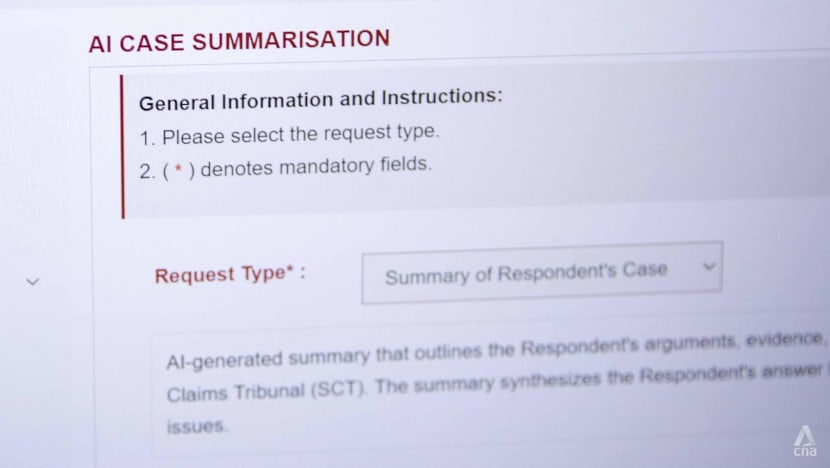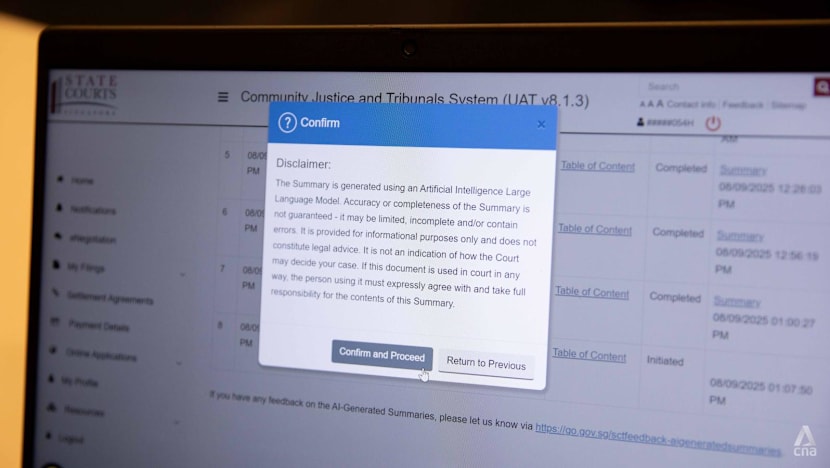Judiciary to launch generative AI tool to summarise cases for small claims tribunals
The tool will help distil factual and legal issues in the claimant's or respondent's case.

A new AI-powered case summarisation tool for individuals representing themselves in small claims tribunal cases. (Photo: CNA/Lim Li Ting)

This audio is generated by an AI tool.
SINGAPORE: To help self-represented individuals handle their own cases, consumers seeking quick redress against errant merchants will soon be able to use a generative AI tool provided by the courts to help condense lengthy documents into more accessible text.
Individuals filing or responding to claims in the small claims tribunals - where consumers can seek claims of up to S$20,000 (US$15,600) or S$30,000 where mutually agreed - can use the tool to improve their understanding of the cases and help them prepare their court documents.
The tool was launched on Wednesday (Sep 10) for use only by tribunal magistrates to summarise case documents, and will be rolled out to claimants and respondents in November, with the specific date to be announced later, the Singapore Courts said in a release.
The tool was developed by the Singapore judiciary in collaboration with Harvey AI. The Singapore Courts signed a memorandum of understanding with the American start-up to use its technology for two years in 2023. They renewed and expanded their collaboration in another such memorandum on Sep 8 this year.
The new feature builds on an earlier generative AI-powered document translation service as part of a broader effort to enable better access to justice through technology.
Claimants and respondents in the small claims tribunals are self-represented and no lawyers are involved.
Last year, there were more than 11,000 cases handled by the small claims tribunals, compared with more than 10,000 in 2023 and more than 9,000 in 2022.
Currently, claimants and respondents file their own papers, which can include receipts, WhatsApp correspondence and other evidence. They have to read through sometimes voluminous documents from the opposing side while preparing their own.
With the new AI summary tool, tribunal magistrates can now also use it to prepare for trial with "a good understanding of the facts involved in each dispute", said the Singapore Courts.
"By streamlining the analysis of documents, the tool allows tribunal magistrates to focus their time and expertise on the more complex aspects of a case, ensuring that high standards of judicial adjudication are maintained even as the volume of claims continue to rise," said the Singapore Courts.
HOW THE TOOL WORKS
Claimants and respondents are able to see documents uploaded by themselves and the other party on the Community Justice and Tribunals System (CJTS) portal online.
There will be a new tab for the AI generation of the summary, and users can select which documents they want to be summarised.
The summary takes 10 to 15 minutes. There will also be logs of previous requests for such summaries in the user's system.

The resulting summary will distil the legal and factual issues raised and the claims and theories of the case.
Before the tool can be used, a disclaimer will pop up saying that the summary is generated using an artificial intelligence large language model, and that accuracy or completeness is not guaranteed.
The disclaimer makes it clear that the summary is for "informational purposes only" and does not constitute legal advice, nor is it an indication of how the court may decide the case.
"If this document is used in court in any way, the person using it must expressly agree with and take full responsibility for the contents of this summary," the disclaimer concludes.
The case summarisation algorithm runs optical character recognition, which is designed to read text from any image, whether it is a PDF, scanned document or a photo of a screen.
However, the quality of the image is key, so a clear screenshot of a WhatsApp conversation, for example, with sharp text would ensure higher accuracy.
The Singapore Courts said it would be monitoring user feedback after the launch, to continually refine the system and better serve their needs. Users can provide feedback via an online form within the case folder in the CJTS.
"We are committed to harnessing the power of technology to improve access to justice for all. This new AI tool is a testament to that mission, helping our tribunal magistrates manage an increasing caseload while maintaining the judiciary's high standards of quality and fairness," said Mr Tan Ken Hwee, the judiciary's Chief Transformation and Innovation Officer.














